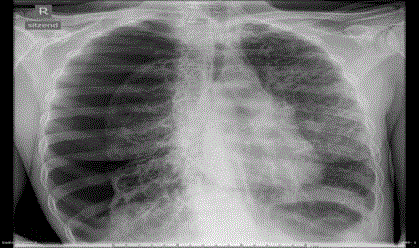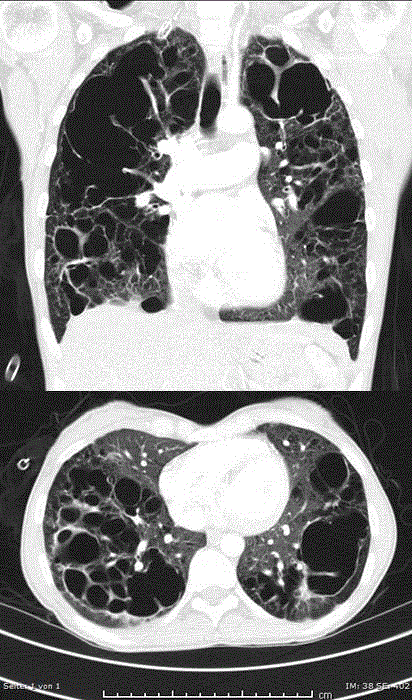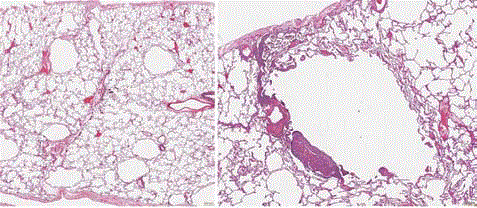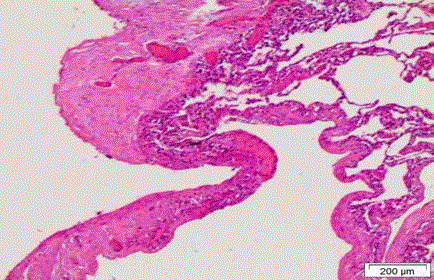Case Blog
Difficult Diagnosis and Rare Morphology of Lymphangioleiomyomatosis with Giant Cysts
Welter S1*, Thrull P1, Westhoff M1, Bach P1, Popper H2 and Maschek H3
1Lung Clinic Hemer, Center for Pneumology and Thoracic Surgery, Germany
2Institute of Pathology, Medical University of Graz, Austria
3Synlab, Pathology Laboratory, Germany
*Corresponding author: Welter S, Department of Pneumology and Thoracic Surgery, Lung Clinic Hemer, Center for Pneumology and Thoracic Surgery, Germany
Published: 01 Oct, 2018
Cite this article as: Welter S, Thrull P, Westhoff M, Bach
P, Popper H, Maschek H. Difficult
Diagnosis and Rare Morphology of
Lymphangioleiomyomatosis with Giant
Cysts. Clin Surg. 2018; 3: 2128.
Introduction
Diffuse cystic lung disease has many differential diagnoses which can be challenging to establish in some cases. Especially non-characteristic clinical presentation, unusual computed scan morphology and rare histologic findings needs the collaboration of different specialists to identify the underlying disease.
Case Blog
We report on a 32-year-old woman without relevant pulmonary symptoms in the past. She was transferred into our hospital with a second manifestation of a tension pneumothorax two weeks after external drainage therapy (Figure 1). After immediate chest tube insertion the Computed Tomogram (CT) of the chest revealed multiple bilateral pulmonary cysts with thin walls (Figure 2). The CT examination showed large cystic lesions with small walls with a maximum diameter up to 10 cm distributed all over both lungs. No fluid collections or nodules were present. Between those lesions normal lung parenchyma was present. The patient is a never-smoker and Alpha-1- antitrypsin was within normal ranges. A minimally invasive wedge resection from the right upper lobe followed by a spared talcum poudrage was performed. The postoperative course was prolonged by air leak but finally resolved after one week. Elaborate histologic evaluation showed lung tissue with large cystic spaces partially with smooth muscle structures in the walls including interlobular septa (Figure 3 and 4). Furthermore some walls were covered by a CD31 and sporadic D2-40 positive layer of endothelial cells. CD34 was negative, but rare HMB-45 positive Perivascular Epitheloid Cells (PEC) were found by a reference pathologist. Parts of the cystic walls were fibrosed, and some cysts seem to have lymphatic origin. The final pathologic consensus diagnosis was a lymphangioleiomyomatosis. Differential diagnoses like langerhans cell histiocytosis, and Birt Hogg Dube syndrome were excluded by histology and radio morphology. Congenital pulmonary adenomatoid malformation did not match with the case concerning distribution of the cysts. The patient was informed about the diagnosis and moved back into her home country.
Discussion
The differential diagnoses of diffuse cystic lung diseases include congenital malformations,
neoplastic, inflammatory, infectious diseases and emphysema changes from smoking [1]. Large
cysts in non-smoking adults are suspicious for Congenital Pulmonary Adenomatoid Malformations
(CPAM). The latter ones are usually thin walled multiple cystic
masses unilateral in one lobe and the cysts are lined by epithelial cells
often able to produce mucus [2,3]. This definition of CPAM does not
fit with our case. Because in this case the morphology was unusual for
any type of Congenital Cystic Pulmonary Malformation (CPAM) and
immunohistochemistry demonstrated a lymphatic origin of the cysts
stained by CD31 and D2-40, the preliminary pathologic diagnosis
was lymphangiomatosis. Lymphangiomatosis usually comes along
with collections of chylus, chylothorax or dilated fluid filled lymph
vessels [4]. Diffuse pulmonary lymphangiomatosis is characterized by
abnormally dilated or reduplicated lymphatic spaces in the lung and
extra thoracic organs [4]. Other authors described lymphangiomatosis
is a rare disease characterized by diffuse infiltration of lymphangiomas
in the lung, bone, kidney and other organs [5]. Again, none of these
conditions were found in this patient.
Lymphangioleiomyomatosis is characterized as a low-grade,
destructive, metastasizing neoplasm, and manifests as the proliferation
of abnormal smooth muscle-like cells in the lung stroma. The goldstandard
immuno-histochemical diagnostic for LAM is immune
positive reaction with HMB-45 antibody. Besides HMB-45, the most
commonly used markers in the immuno-histochemical diagnosis of
LAM are α-Smooth Muscle Actin (αSMA), Estrogen Receptor (ER),
and Progesterone Receptor (PR) [6,7].
Figure 1
Figure 1
Chest X-ray at the day of admission with a tension pneumothorax on the right side. Emphysematous
changes, cysts and fibrous strands are homogenously distributed over both lungs.
Figure 2
Figure 2
Chest CT-scan after insertion of a chest tube demonstrating large
bilateral central cysts with thin walls surrounded by unchanged and slightly
emphysematous lung tissue.
Figure 3
Figure 3
H&E stained section. Left, overview of cystic lesions. Bar 400 μm.
Right, cystic lesion with pronounced muscular proliferation. Bar 200 μm.
Figure 4
Conclusion
This case illustrates that immunohistochemistry for HMB-45 may be negative, although LAM is present. If clinical suspicion for LAM is high, repeated HMB-45-immunohistochemistry of additional histological sections should be forwarded, because sometimes there may be only scarce HMB-45 positivity. The establishment of a definite LAM-diagnosis has relevant therapeutic implications, especially regarding mTOR-inhibitor-therapy.
References
- Baldi BG, Carvalho CRR, Dias OM, Marchiori E, Hochhegger B. Diffuse cystic lung diseases: differential diagnosis. J Bras Pneumol. 2017;43(2):140-9.
- Stocker JT, Madewell JE, Drake RM. Congenital cystic adenomatoid malformation of the lung. Classification and morphologic spectrum. Hum Pathol. 1977;8(2):55-71.
- Kim WS, Lee KS, Kim IO, Suh YL, Im JG, Yeon KM, et al. Congenital cystic adenomatoid malformation of the lung: CT-pathologic correlation. AJR Am J Roentgenol. 1997;168(1):47-53.
- Zhao J, Wu R, Gu Y. Pathology analysis of a rare case of diffuse pulmonary lymphangiomatosis. Ann Transl Med. 2016;4(6):114.
- Zhang J, Jin H, Wang Y, Bai C, Han Y. A case of diffuse pulmonary lymphangiomatosis with unilateral lung invasion. Oxf Med Case Reports. 2015;10:346-8.
- Grzegorek I, Lenze D, Chabowski M, Janczak D, Szolkowska M, Langfort R, et al. Immunohistochemical evaluation of pulmonary lymphangioleiomyomatosis. Anticancer Res. 2015;35(6):3353-60.
- Johnson SR, Cordier JF, Lazor R, Cottin V, Costabel U, Harari S, et al. European Respiratory Society guidelines for the diagnosis and management of lymphangioleiomyomatosis. Eur Respir J. 2010;35(1):14-26.




